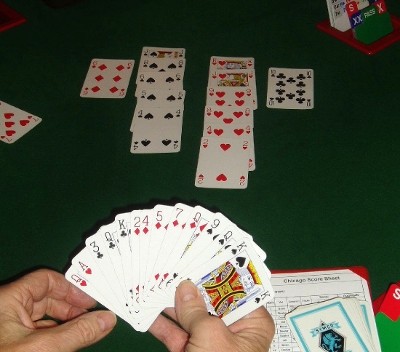Count and Count Again Bridge
To anyone who is prepared to listen, I'm always on about the need to count: Count your tricks. Count your losers. Count the outstanding trumps. Count the opponents' points as the hand unfolds. Count, count, count again.
One can often get an exact picture of the opponents' distribution from the bidding and counting the cards they subsequently play to the initial tricks, enabling you to pinpoint the winning line to take as declarer. Consider the following hand which came up in a recent club pairs competition:
North | ||||||||
♠ 8 | ||||||||
♥ K 8 4 2 | ||||||||
♦ A Q J 10 | ||||||||
♣ A 7 6 5 | ||||||||
South (You) | ||||||||
♠ A Q | ||||||||
♥ A 6 5 | ||||||||
♦ K 9 8 4 | ||||||||
♣ K 9 4 3 West as dealer opens the biding with a weak, pre-emptive bid of 2♠, showing 6 cards in the spade suit and less than 11 points. Your partner, sitting North, doubles for takeout, East passes and you bid 3NT, the final contract. West leads the ♥Q and when dummy comes down you can count 9 tricks on top - 4 in diamonds, 2 in each of hearts and clubs, and one in spades – so your contract is safe. However, other declarers may have received a spade lead giving them 10 tricks on top from the outset, but, in any event, it's vital in top-bottom scoring that you make an over-trick. Where is it going to come from? If West started with only 3 hearts, the suit breaks 3-3 and dummy's fourth heart will be your 10th trick. Alternatively, if clubs break 3-2, the extra trick will come from that suit. In order to count out the exact distribution, you duck the first heart, win West's ♥J continuation with your ♥A in hand and play a third round of hearts, winning with the ♥K in dummy. East shows out, discarding a small spade. The overtrick is going to have to come from elsewhere You already have an almost complete picture of West's hand. Having started with 6 cards in spades and 4 in hearts, he has 3 cards in the minors. You continue your voyage of discovery by winning the next 3 tricks with the ♦K, ♦A and ♦Q. West follows to the first two and discards a spade on the third round of diamonds. You now know he has at most a single club. If the lonely card is the Q, J or 10, you can still establish the ♣9 as your extra trick so you play the ♣A from dummy. Alas, West's singleton is the littlest ♣2. But is all lost? No. The 6 cards left in the West hand are the ♥10 and 5 spades, presumably headed by the ♠K. So, you play dummy's last heart, throwing in West who has no alternative now but to lead a spade into the waiting jaws of your ♠A Q, thereby giving you your hard-sought over-trick. A second example of counting out the opponents' distributions came up in the same tournament: North ♠ K J 10 ♥ 3 2 ♦ K J 10 9 ♣ Q 10 7 4 ♠ A Q 9 7 5 ♥ J 7 ♦ A 5 4 3 2 ♣ 6
| ||||||||








Comments